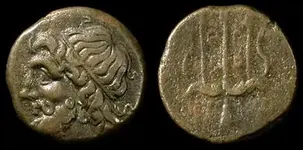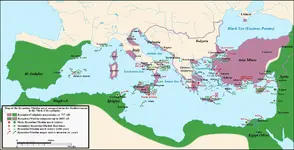Hola amigos;
This reply is very long, so I must beg your indulgence; I recommend refilling your coffee now if you intend to read the whole thing, thank you in advance.

Starman 1 wrote
Gentlemen:
Hello Roy,
I really enjoyed reading your response. I have to say I am still curious as to your belief regarding the artifacts. If after reviewing the evidence you still believe this is all a fraud, what point is there in going forward?
I was attempting to allow you and your supporters the greatest possible latitude, considering this discussion has gone on for several years now and the claim made that the Tucson artifacts held by the museum (in Tucson) are copies of the real ones. If there are real ones, then this story of an exodus and ensuing colony
would have other evidence to support it, like a record of the exodus from the Byzantine empire or
somewhere in the Old World, a few artifacts or relics or inscriptions found elsewhere in America and in particular the southwest, indicating this colony existed or that the people passed through. So far nothing has been presented to indicate there was an emigration from the Old World to match the Calalus story, and the closest to any kind of evidence corresponding to the correct time period would be St Brendan's voyage which is recorded in a most fanciful way <
and being monks certainly not a viable colony>, or prince Madoc's voyage which is too late. There are also bits of evidence of accidental Arab visitors to America as well, but again too late to make the 700 AD time period and the wrong culture/people/language as well.
Starman 1 also wrote
Why do you suppose folks have ventured into the southwest for centuries? Do you really believe the settlers of Calalus were the first here to look for the treasure the people found? Perhaps the unifying piece of the puzzle of Hidden Mountain and the Tucson Artifacts is that both groups were looking for the same thing. The same thing that led Coronado to the top of Coronado Mesa in his failed attempt to locate the library of Oz.
I "suppose" the first Old World people to venture into the Southwest arrived in America by accident,
as is recorded by Diodorus and Aristotle, or as in the example of the first Norseman to see America, Bjarni Herjulfsson. Powerful storms have carried ships across both the Atlantic and Pacific oceans, including in recent history. Further visits were for gold, silver, timber, furs and fish, and even one attempted colony (
not Roman/Samaritan) which was withdrawn by order of the govt.
Starman 1 also wrote
In terms of the Critias there are several complete copies of the dialogue still around. We have one, the Vatican, and surprisingly enough the Mormon Church. There are probably others out there but I would not expect one to show up on e-bay anytime soon. I would be surprised if the Vatican will share theirs.
I don't know why you would assume that my main sources come from Ebay, and it is easy to say that such copies exist in places that are not accessible. I am very confident that if any other portion of Critias were found to exist,
it would not be kept a secret. Even documents which have been suppressed by powerful forces for centuries, like the gospel of Judas, have come to light in recent times. The best hope for a complete document of Critias, if it was ever completed, may be in the library of Herculaneum, but we may not live long enough to see the recovered documents.
BBC News - Unlocking the scrolls of Herculaneum
Considering that
Plutarch, writing in the first century AD and long before our time,
stated that Plato never finished his work on Atlantis, this certainly suggests that any "unpublished portion"
was already lost by 100 AD and we might add, if Plutarch is granted any credence, then
there is no unpublished portion for it was never completed. However I had hoped that perhaps you had something to support the contention, as it would be a major coup to find any unpublished portion of Plato's works. Surprising new finds are made all the time.
I fail to see any mention of the Trident in Timaeus; while I am in complete agreement that the reference to the "true continent" which bounds the whole of the western ocean is the Americas, what exactly ties this to Calalus? Atlantis and Calalus are separated by some 10,200 years roughly) not to mention the cultural/linguistic gaps. It is POSSIBLE that the Trident was a symbol of Atlantis, but I doubt it on several grounds. Firstly, it is the symbol of Poseidon, one of the Olympian gods of top ranks, and not of the Titans which are the basis of Atlantis. Remember
Atlas was a Titan, not an Olympian, so the symbology doesn't work. I would ask where Plato states that the name given to the continent of America is Calalus, but you would probably point to that "unpublished portion" again. There is some reason to believe the ancient Greek name for the American continent was Ogygia, which is not etemiologically similar to Calalus. That ancient visitors from the Old World not only knew of America but were visiting, and in surprising places at that, we might note that the Punic name of Alaska is Al Asqa, pronounced exactly the same as we pronounce Alaska, which supposedly means "the great land" in native tongue and coincidentally, is the exact same meaning for the Punic name. Geographic place names often live far longer than the people whom gave a place the name, and there is no Amerindian place name close to Calalus for that area which I have been able to find.
Starman 1 also wrote
And what did these explorers leave us after taking the precious metals and other things? The library of Oz. Directions? Not sure we can say anything more than was posted several years ago:
The best answer as to what ancient explorers left us, after obtaining the precious metals, furs etc they came for, is
graffiti; much the same as early Spanish explorers and American emigrants crossing to Oregon carved their names on Independence Rock in Wyoming. A few coins have been found, a metal urn, and a few actual shipwrecks as well. None of these date to 700-800 AD however, all are much older. I have never seen anything to substantiate the story of a "library of Oz"; in fact the one state/power that did attempt a colony in America from the Old World, was destroyed including its libraries, circa 149 BC. It is possible that some of those people escaped to America, in fact there is even an incident which may record the actual departure of these refugee type colonists, and the time period will not match Calalus.
If you think about it, the story of these "holy relics' being
DUMPED should be a major red flag.
If they were truly holy, why would they have been handled with so little respect?
Starman 1 also wrote
Roy, one day I hope you hike that trail and who knows maybe the next time you are in Fish Creek Canyon you will see what has always been there, the gate to Calalus and beyond.
I have no plans to return to Fish creek and my sole reason for that most unpleasant hike on my last visit had nothing to do with Calalus, Oz nor gold or treasures.
You have pointed out that it takes a "leap of faith" to believe in Calalus and/or Oz, that we must virtually "suspend" our logic and simply accept it, which is not a way to convince skeptics. If you must be a believer to see it, then there is a strong chance it does not exist.
If you really wonder why I have continued to discuss this topic with you and the other supporters of Calalus/Oz, it is because I have long been working on a book about ancient visitors from the Old World coming to America. As things stand, Calalus does not look to be genuine to me, and while this may seem harmless such fantasies
can actually be harmful. We need only look to the rise of the Nazis and their invented mythology of the Aryans to see how a fantasy version of history can become very destructive indeed. I am NOT proposing that you or any of the other believers in Calalus are anything like the Nazis, just using that extreme example to show how such a fiction can be very destructive; ala a belief in some "special" or "superior" race of people, whom have been persecuted and the next step is the drive to "restore" this mythical empire.
Even in my own work, were I to include Calalus and in effect put my "stamp of approval" on it, the effect would be to put my credibility and judgement into question for having thus approved of such a questionable set of artifacts. I do not approve of them as genuine, and including them as evidence of ancient Old World voyages to America would actually hurt the argument by casting a shadow on the whole. The Calalus artifacts are not the only examples of such questionable evidence, we can point to the "ancient Hebrew" coins found in Kentucky or the Cardiff Giant of NY, fakes and phony "evidence" have been turning up right along. Don't believe everything that comes along, the real evidence is compelling enough by itself.
Real history is every bit as interesting, and full of surprises as Calalus, more so in fact, we need not look to fantasy or invented stories, and much of history remains to be told. I am sorry but Calalus is not a part of it in my
opinion, which as our mutual amigo Cactusjumper says, with five bucks
might buy you a cup of coffee.
Good luck and good hunting to you Starman, and everyone reading our discussion, I think I am done with this thread as I have no intention of making any leap of faith to accept Calalus. I hope you find the treasures that you seek.
Oroblanco













